Accelerated Discovery of Halide Perovskite Materials via Computational Methods: A Review
Abstract
:1. Introduction
2. Computational Tools
2.1. Structural Stability
2.2. Electronic Structure
2.3. Rational Design and High-Throughput Screening
3. Accelerated Discovery of Novel Halide Perovskites
3.1. Vacancy-Ordered Double Perovskites: A2BX6

3.2. Traditional Double Perovskites: A2BB′X6
3.3. Perovskite-Related Materials: A3B2X9
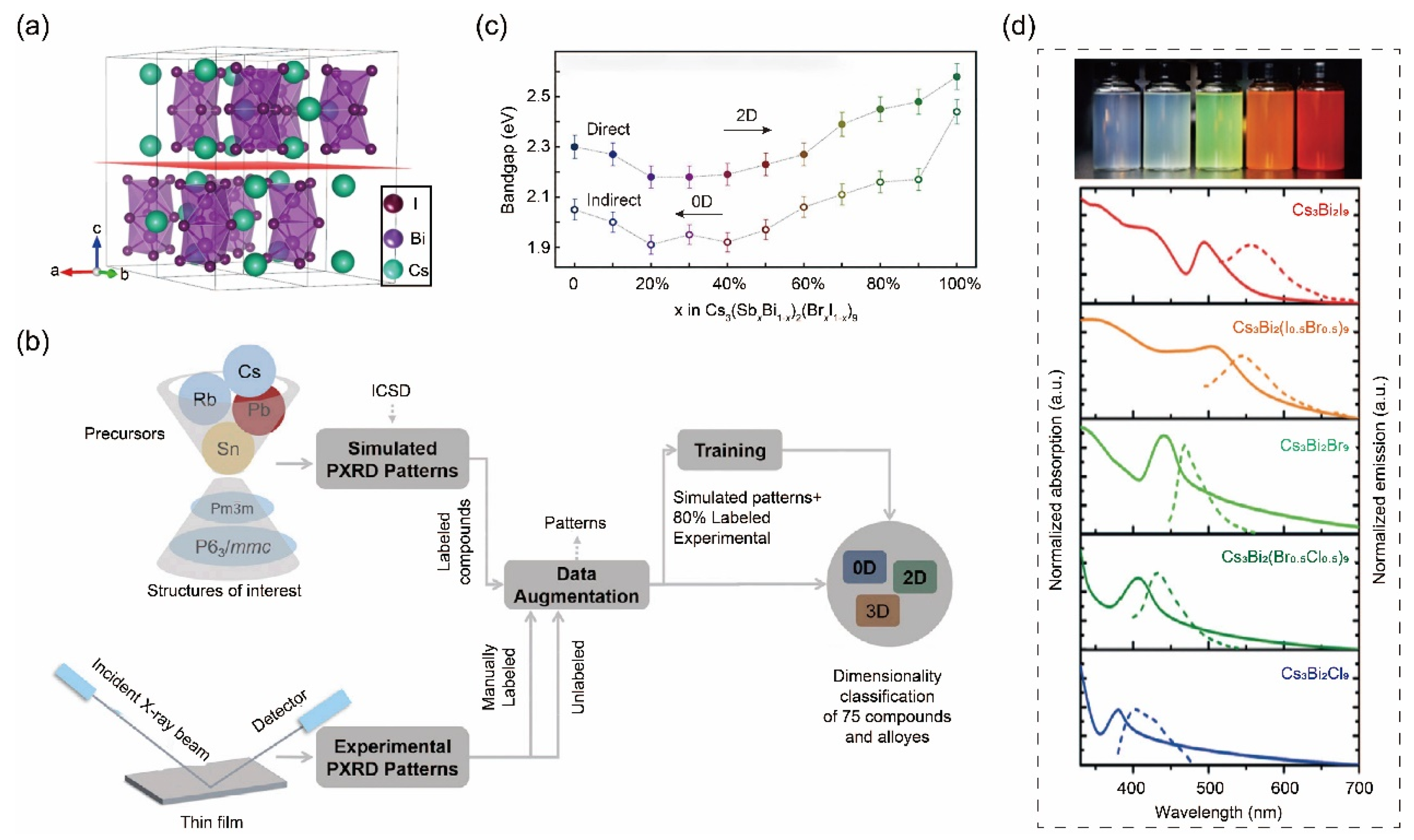
3.4. Novel Halide Perovskites: ABX6
4. Conclusions and Perspectives
Author Contributions
Funding
Data Availability Statement
Conflicts of Interest
References
- Jena, A.K.; Kulkarni, A.; Miyasaka, T. Halide Perovskite Photovoltaics: Background, Status, and Future Prospects. Chem. Rev. 2019, 119, 3036–3103. [Google Scholar] [CrossRef] [PubMed]
- Liu, S.; Cheng, Z.; Li, M.-Y.; Liu, S.; Lu, H.; Wen, X.; Wang, C.; Ding, X.; Wang, L. Synapses Based on Lead-Free Perovskite in Artificial Intelligence. Matter 2024. [Google Scholar] [CrossRef]
- Dai, J.; Ma, L.; Ju, M.; Huang, J.; Zeng, X.C. In- and Ga-Based Inorganic Double Perovskites with Direct Bandgaps for Photovoltaic Applications. Phys. Chem. Chem. Phys. 2017, 19, 21691–21695. [Google Scholar] [CrossRef] [PubMed]
- Jain, A.; Voznyy, O.; Sargent, E.H. High-Throughput Screening of Lead-Free Perovskite-like Materials for Optoelectronic Applications. J. Phys. Chem. C 2017, 121, 7183–7187. [Google Scholar] [CrossRef]
- Han, D.; Feng, C.; Du, M.-H.; Zhang, T.; Wang, S.; Tang, G.; Bein, T.; Ebert, H. Design of High-Performance Lead-Free Quaternary Antiperovskites for Photovoltaics via Ion Type Inversion and Anion Ordering. J. Am. Chem. Soc. 2021, 143, 12369–12379. [Google Scholar] [CrossRef] [PubMed]
- Lyu, M.; Yun, J.; Chen, P.; Hao, M.; Wang, L. Addressing Toxicity of Lead: Progress and Applications of Low-Toxic Metal Halide Perovskites and Their Derivatives. Adv. Energy Mater. 2017, 7, 1602512. [Google Scholar] [CrossRef]
- Zhou, Y.; Zhao, Y. Chemical Stability and Instability of Inorganic Halide Perovskites. Energy Environ. Sci. 2019, 12, 1495–1511. [Google Scholar] [CrossRef]
- Pan, S.; Li, J.; Wen, Z.; Lu, R.; Zhang, Q.; Jin, H.; Zhang, L.; Chen, Y.; Wang, S. Halide Perovskite Materials for Photo(Electro)Chemical Applications: Dimensionality, Heterojunction, and Performance. Adv. Energy Mater. 2022, 12, 2004002. [Google Scholar] [CrossRef]
- Maughan, A.E.; Ganose, A.M.; Bordelon, M.M.; Miller, E.M.; Scanlon, D.O.; Neilson, J.R. Defect Tolerance to Intolerance in the Vacancy-Ordered Double Perovskite Semiconductors Cs2SnI6 and Cs2TeI6. J. Am. Chem. Soc. 2016, 138, 8453–8464. [Google Scholar] [CrossRef]
- Gao, Y.; Lv, X.; Lv, Z.; Peng, B.; Zheng, G.; Huang, F. Vacancy-Ordered Superstructure-Induced Delocalized States Enable Superior Sodium Ion Storage. Adv. Funct. Mater. 2023, 33, 2306184. [Google Scholar] [CrossRef]
- Chen, W.; Liu, G.; Dong, C.; Guan, X.; Gao, S.; Hao, J.; Chen, C.; Lu, P. Investigation of Vacancy-Ordered Double Perovskite Halides A2Sn1−xTixY6 (A = K, Rb, Cs; Y = Cl, Br, I): Promising Materials for Photovoltaic Applications. Nanomaterials 2023, 13, 2744. [Google Scholar] [CrossRef]
- Shi, X.; Lin, X.; Luo, R.; Wu, S.; Li, L.; Zhao, Z.-J.; Gong, J. Dynamics of Heterogeneous Catalytic Processes at Operando Conditions. JACS Au 2021, 1, 2100–2120. [Google Scholar] [CrossRef] [PubMed]
- Travis, W.; Glover, E.N.K.; Bronstein, H.; Scanlon, D.O.; Palgrave, R.G. On the Application of the Tolerance Factor to Inorganic and Hybrid Halide Perovskites: A Revised System. Chem. Sci. 2016, 7, 4548–4556. [Google Scholar] [CrossRef] [PubMed]
- Li, Z.; Yang, M.; Park, J.-S.; Wei, S.-H.; Berry, J.J.; Zhu, K. Stabilizing Perovskite Structures by Tuning Tolerance Factor: Formation of Formamidinium and Cesium Lead Iodide Solid-State Alloys. Chem. Mater. 2016, 28, 284–292. [Google Scholar] [CrossRef]
- Gu, G.H.; Noh, J.; Kim, I.; Jung, Y. Machine Learning for Renewable Energy Materials. J. Mater. Chem. A 2019, 7, 17096–17117. [Google Scholar] [CrossRef]
- Sun, S.; Hartono, N.T.P.; Ren, Z.D.; Oviedo, F.; Buscemi, A.M.; Layurova, M.; Chen, D.X.; Ogunfunmi, T.; Thapa, J.; Ramasamy, S.; et al. Accelerated Development of Perovskite-Inspired Materials via High-Throughput Synthesis and Machine-Learning Diagnosis. Joule 2019, 3, 1437–1451. [Google Scholar] [CrossRef]
- Pilania, G.; Balachandran, P.V.; Kim, C.; Lookman, T. Finding New Perovskite Halides via Machine Learning. Front. Mater. 2016, 3, 19. [Google Scholar] [CrossRef]
- Lu, S.; Zhou, Q.; Ouyang, Y.; Guo, Y.; Li, Q.; Wang, J. Accelerated Discovery of Stable Lead-Free Hybrid Organic-Inorganic Perovskites via Machine Learning. Nat. Commun. 2018, 9, 3405. [Google Scholar] [CrossRef]
- Wang, H.; Ji, Y.; Li, Y. Simulation and Design of Energy Materials Accelerated by Machine Learning. WIREs Comput. Mol. Sci. 2020, 10, e1421. [Google Scholar] [CrossRef]
- Raman, A.S.; Vojvodic, A. Modeling Exsolution of Pt from ATiO3 Perovskites (A = Ca/Sr/Ba) Using First-Principles Methods. Chem. Mater. 2020, 32, 9642–9649. [Google Scholar] [CrossRef]
- Tan, Z.; Chu, Y.; Chen, J.; Li, J.; Ji, G.; Niu, G.; Gao, L.; Xiao, Z.; Tang, J. Lead-Free Perovskite Variant Solid Solutions Cs2Sn1–xTexCl6 : Bright Luminescence and High Anti-Water Stability. Adv. Mater. 2020, 32, 2002443. [Google Scholar] [CrossRef] [PubMed]
- Kieslich, G.; Sun, S.; Cheetham, A.K. Solid-State Principles Applied to Organic–Inorganic Perovskites: New Tricks for an Old Dog. Chem. Sci. 2014, 5, 4712–4715. [Google Scholar] [CrossRef]
- Bartel, C.J.; Sutton, C.; Goldsmith, B.R.; Ouyang, R.; Musgrave, C.B.; Ghiringhelli, L.M.; Scheffler, M. New Tolerance Factor to Predict the Stability of Perovskite Oxides and Halides. Sci. Adv. 2019, 5, eaav0693. [Google Scholar] [CrossRef]
- Li, Z.; Achenie, L.E.K.; Xin, H. An Adaptive Machine Learning Strategy for Accelerating Discovery of Perovskite Electrocatalysts. ACS Catal. 2020, 10, 4377–4384. [Google Scholar] [CrossRef]
- Sun, J.; Zheng, W.; Huang, P.; Zhang, M.; Zhang, W.; Deng, Z.; Yu, S.; Jin, M.; Chen, X. Efficient Near-Infrared Luminescence in Lanthanide-Doped Vacancy-Ordered Double Perovskite Cs2ZrCl6 Phosphors via Te4+ Sensitization. Angew. Chem. Int. Ed. 2022, 61, e202201993. [Google Scholar] [CrossRef]
- Wang, X.; Meng, W.; Liao, W.; Wang, J.; Xiong, R.-G.; Yan, Y. Atomistic Mechanism of Broadband Emission in Metal Halide Perovskites. J. Phys. Chem. Lett. 2019, 10, 501–506. [Google Scholar] [CrossRef] [PubMed]
- Kangsabanik, J.; Sugathan, V.; Yadav, A.; Yella, A.; Alam, A. Double Perovskites Overtaking the Single Perovskites: A Set of New Solar Harvesting Materials with Much Higher Stability and Efficiency. Phys. Rev. Mater. 2018, 2, 055401. [Google Scholar] [CrossRef]
- Zhou, P.; Chen, H.; Chao, Y.; Zhang, Q.; Zhang, W.; Lv, F.; Gu, L.; Zhao, Q.; Wang, N.; Wang, J.; et al. Single-Atom Pt-I3 Sites on All-Inorganic Cs2SnI6 Perovskite for Efficient Photocatalytic Hydrogen Production. Nat. Commun. 2021, 12, 4412. [Google Scholar] [CrossRef] [PubMed]
- Xiao, Z.; Yan, Y.; Hosono, H.; Kamiya, T. Roles of Pseudo-Closed s2 Orbitals for Different Intrinsic Hole Generation between Tl–Bi and In–Bi Bromide Double Perovskites. J. Phys. Chem. Lett. 2018, 9, 258–262. [Google Scholar] [CrossRef]
- Kumar, A.; Rana, A.; Vashistha, N.; Garg, K.K.; Singh, R.K. Defect States Influencing Hysteresis and Performance of Perovskite Solar Cells. Sol. Energy 2020, 211, 345–353. [Google Scholar] [CrossRef]
- Ibrahim; Shoukat, A.; Aslam, F.; Israr Ur Rehman, M. Emerging Trends in Low Band Gap Perovskite Solar Cells: Materials, Device Architectures, and Performance Optimization. Mol. Phys. 2024, e2316273. [Google Scholar] [CrossRef]
- Koch, G.; Hävecker, M.; Teschner, D.; Carey, S.J.; Wang, Y.; Kube, P.; Hetaba, W.; Lunkenbein, T.; Auffermann, G.; Timpe, O.; et al. Surface Conditions That Constrain Alkane Oxidation on Perovskites. ACS Catal. 2020, 10, 7007–7020. [Google Scholar] [CrossRef]
- Liao, W.; Zhao, D.; Yu, Y.; Shrestha, N.; Ghimire, K.; Grice, C.R.; Wang, C.; Xiao, Y.; Cimaroli, A.J.; Ellingson, R.J.; et al. Fabrication of Efficient Low-Bandgap Perovskite Solar Cells by Combining Formamidinium Tin Iodide with Methylammonium Lead Iodide. J. Am. Chem. Soc. 2016, 138, 12360–12363. [Google Scholar] [CrossRef]
- Gu, G.H.; Jang, J.; Noh, J.; Walsh, A.; Jung, Y. Perovskite Synthesizability Using Graph Neural Networks. NPJ Comput. Mater. 2022, 8, 71. [Google Scholar] [CrossRef]
- Schmidt, J.; Pettersson, L.; Verdozzi, C.; Botti, S.; Marques, M.A.L. Crystal Graph Attention Networks for the Prediction of Stable Materials. Sci. Adv. 2021, 7, eabi7948. [Google Scholar] [CrossRef] [PubMed]
- Xiao, Z.; Meng, W.; Wang, J.; Mitzi, D.B.; Yan, Y. Searching for Promising New Perovskite-Based Photovoltaic Absorbers: The Importance of Electronic Dimensionality. Mater. Horiz. 2017, 4, 206–216. [Google Scholar] [CrossRef]
- Morgan, E.E.; Kent, G.T.; Zohar, A.; O’Dea, A.; Wu, G.; Cheetham, A.K.; Seshadri, R. Hybrid and Inorganic Vacancy-Ordered Double Perovskites A2WCl6. Chem. Mater. 2023, 35, 7032–7038. [Google Scholar] [CrossRef]
- Zheng, K.; Chen, B.; Xie, L.; Li, X.; Lu, B.; Wang, M.; Wu, Y.; Jiang, T.; Zhang, F.; Li, X.; et al. Vacancy-Ordered Double Perovskite Rb2ZrCl6−xBrx: Facile Synthesis and Insight into Efficient Intrinsic Self-Trapped Emission. Adv. Opt. Mater. 2022, 10, 2101661. [Google Scholar] [CrossRef]
- Grandhi, G.; Matuhina, A.; Liu, M.; Annurakshita, S.; Ali-Löytty, H.; Bautista, G.; Vivo, P. Lead-Free Cesium Titanium Bromide Double Perovskite Nanocrystals. Nanomaterials 2021, 11, 1458. [Google Scholar] [CrossRef]
- Liu, A.; Zhu, H.; Reo, Y.; Kim, M.-G.; Chu, H.Y.; Lim, J.H.; Kim, H.-J.; Ning, W.; Bai, S.; Noh, Y.-Y. Modulation of Vacancy-Ordered Double Perovskite Cs2SnI6 for Air-Stable Thin-Film Transistors. Cell Rep. Phys. Sci. 2022, 3, 100812. [Google Scholar] [CrossRef]
- Yin, H.; Chen, J.; Guan, P.; Zheng, D.; Kong, Q.; Yang, S.; Zhou, P.; Yang, B.; Pullerits, T.; Han, K. Controlling Photoluminescence and Photocatalysis Activities in Lead-Free Cs2PtxSn1−xCl6 Perovskites via Ion Substitution. Angew. Chem. 2021, 133, 22875–22881. [Google Scholar] [CrossRef]
- Cai, Y.; Xie, W.; Ding, H.; Chen, Y.; Thirumal, K.; Wong, L.H.; Mathews, N.; Mhaisalkar, S.G.; Sherburne, M.; Asta, M. Computational Study of Halide Perovskite-Derived A2BX6 Inorganic Compounds: Chemical Trends in Electronic Structure and Structural Stability. Chem. Mater. 2017, 29, 7740–7749. [Google Scholar] [CrossRef]
- Ju, M.-G.; Chen, M.; Zhou, Y.; Garces, H.F.; Dai, J.; Ma, L.; Padture, N.P.; Zeng, X.C. Earth-Abundant Nontoxic Titanium(IV)-Based Vacancy-Ordered Double Perovskite Halides with Tunable 1.0 to 1.8 eV Bandgaps for Photovoltaic Applications. ACS Energy Lett. 2018, 3, 297–304. [Google Scholar] [CrossRef]
- Gao, Z.; Shen, X.; Lyu, P.; Xu, C.; Fan, D.; Sun, L. Introducing Relatively Isolated In/Out-Gap Bands in Cs2XCl6 (X = Sn, Hf, Zr, Ti) via B-Site Substitution: A Route to Brighter Luminescence and Tunable Emission Wavelengths. Adv. Opt. Mater. 2023, 11, 2300956. [Google Scholar] [CrossRef]
- Wu, R.; Liu, Y.; Hu, S.; Fu, P.; Xiao, Z. Red-Emitting Perovskite Variant Cs2PtCl6 Phosphor: Material Design, Luminous Mechanism, and Application in High-Color-Rendering White Light-Emitting Diodes. Adv. Opt. Mater. 2022, 10, 2201081. [Google Scholar] [CrossRef]
- Peng, H.; Xu, L.; Sheng, Y.; Sun, W.; Yang, Y.; Deng, H.; Chen, W.; Liu, J. Highly Conductive Ligand-Free Cs2PtBr6 Perovskite Nanocrystals with a Narrow Bandgap and Efficient Photoelectrochemical Performance. Small 2021, 17, 2102149. [Google Scholar] [CrossRef]
- Chu, Y.; Hu, Y.; Xiao, Z. First-Principles Insights into the Stability Difference between ABX3 Halide Perovskites and Their A2BX6 Variants. J. Phys. Chem. C 2021, 125, 9688–9694. [Google Scholar] [CrossRef]
- Hamdan, M.; Manoj, M.; Halpati, J.S.; Chandiran, A.K. Acid- and Base-Stable Cs2Pt(Cl,Br)6 Vacancy-Ordered Double Perovskites and Their Core–Shell Heterostructures for Solar Water Oxidation. Sol. RRL 2022, 6, 2101092. [Google Scholar] [CrossRef]
- Yang, B.; Han, K. Ultrafast Dynamics of Self-Trapped Excitons in Lead-Free Perovskite Nanocrystals. J. Phys. Chem. Lett. 2021, 12, 8256–8262. [Google Scholar] [CrossRef]
- Benin, B.M.; Dirin, D.N.; Morad, V.; Wörle, M.; Yakunin, S.; Rainò, G.; Nazarenko, O.; Fischer, M.; Infante, I.; Kovalenko, M.V. Highly Emissive Self-Trapped Excitons in Fully Inorganic Zero-Dimensional Tin Halides. Angew. Chem. Int. Ed. 2018, 57, 11329–11333. [Google Scholar] [CrossRef]
- Li, S.; Luo, J.; Liu, J.; Tang, J. Self-Trapped Excitons in All-Inorganic Halide Perovskites: Fundamentals, Status, and Potential Applications. J. Phys. Chem. Lett. 2019, 10, 1999–2007. [Google Scholar] [CrossRef] [PubMed]
- Liu, Z.; Qin, X.; Chen, Q.; Chen, Q.; Jing, Y.; Zhou, Z.; Zhao, Y.S.; Chen, J.; Liu, X. Highly Stable Lead-Free Perovskite Single Crystals with NIR Emission Beyond 1100 Nm. Adv. Opt. Mater. 2022, 10, 2201254. [Google Scholar] [CrossRef]
- Wang, A.; Yan, X.; Zhang, M.; Sun, S.; Yang, M.; Shen, W.; Pan, X.; Wang, P.; Deng, Z. Controlled Synthesis of Lead-Free and Stable Perovskite Derivative Cs2SnI6 Nanocrystals via a Facile Hot-Injection Process. Chem. Mater. 2016, 28, 8132–8140. [Google Scholar] [CrossRef]
- Chang, T.; Wei, Q.; Zeng, R.; Cao, S.; Zhao, J.; Zou, B. Efficient Energy Transfer in Te4+ -Doped Cs2ZrCl6 Vacancy-Ordered Perovskites and Ultrahigh Moisture Stability via A-Site Rb-Alloying Strategy. J. Phys. Chem. Lett. 2021, 12, 1829–1837. [Google Scholar] [CrossRef]
- Zhang, F.; Zhong, H.; Chen, C.; Wu, X.; Hu, X.; Huang, H.; Han, J.; Zou, B.; Dong, Y. Brightly Luminescent and Color-Tunable Colloidal CH3NH3PbX3 (X = Br, I, Cl) Quantum Dots: Potential Alternatives for Display Technology. ACS Nano 2015, 9, 4533–4542. [Google Scholar] [CrossRef]
- Straus, D.B.; Guo, S.; Abeykoon, A.M.; Cava, R.J. Understanding the Instability of the Halide Perovskite CsPbI3 through Temperature-Dependent Structural Analysis. Adv. Mater. 2020, 32, 2001069. [Google Scholar] [CrossRef]
- Conings, B.; Drijkoningen, J.; Gauquelin, N.; Babayigit, A.; D’Haen, J.; D’Olieslaeger, L.; Ethirajan, A.; Verbeeck, J.; Manca, J.; Mosconi, E.; et al. Intrinsic Thermal Instability of Methylammonium Lead Trihalide Perovskite. Adv. Energy Mater. 2015, 5, 1500477. [Google Scholar] [CrossRef]
- Li, T.; Luo, S.; Wang, X.; Zhang, L. Alternative Lone-Pair Ns2 -Cation-Based Semiconductors beyond Lead Halide Perovskites for Optoelectronic Applications. Adv. Mater. 2021, 33, 2008574. [Google Scholar] [CrossRef] [PubMed]
- Huma, M.; Rashid, M.; Mahmood, Q.; Algrafy, E.; Kattan, N.A.; Laref, A.; Bhatti, A.S. Physical Properties of Lead-Free Double Perovskites A2SnI6 (A= Cs, Rb) Using Ab-Initio Calculations for Solar Cell Applications. Mater. Sci. Semicond. Process. 2021, 121, 105313. [Google Scholar] [CrossRef]
- Niaz, S.; Khan, M.A.; Noor, N.A.; Mahmood, A.; Alanazi, Y.M.; Mumtaz, S. Analysis of Structural Stability and Half-Metallic Ferromagnetism of Cs2VX6 (X=Cl, Br) Double-Perovskites for Spintronic Applications: Ab-Initio Simulations. ECS J. Solid State Sci. Technol. 2023, 12, 093004. [Google Scholar] [CrossRef]
- Boubekraoui, A.; Moatassim, H.; Al-Shami, A.; Ez-Zahraouy, H. DFT Study of Structural, Electronic, and Thermoelectric Properties of Cs2PdX(X=Br2Be2Te2) Compound. Comput. Condens. Matter 2021, 29, e00600. [Google Scholar] [CrossRef]
- Dey, A.; Ye, J.; De, A.; Debroye, E.; Ha, S.K.; Bladt, E.; Kshirsagar, A.S.; Wang, Z.; Yin, J.; Wang, Y.; et al. State of the Art and Prospects for Halide Perovskite Nanocrystals. ACS Nano 2021, 15, 10775–10981. [Google Scholar] [CrossRef] [PubMed]
- Liu, Y.; Nag, A.; Manna, L.; Xia, Z. Lead-Free Double Perovskite Cs2AgInCl6. Angew. Chem. 2021, 133, 11696–11707. [Google Scholar] [CrossRef]
- Jellicoe, T.C.; Richter, J.M.; Glass, H.F.J.; Tabachnyk, M.; Brady, R.; Dutton, S.E.; Rao, A.; Friend, R.H.; Credgington, D.; Greenham, N.C.; et al. Synthesis and Optical Properties of Lead-Free Cesium Tin Halide Perovskite Nanocrystals. J. Am. Chem. Soc. 2016, 138, 2941–2944. [Google Scholar] [CrossRef] [PubMed]
- Liu, M.; Pasanen, H.; Ali-Löytty, H.; Hiltunen, A.; Lahtonen, K.; Qudsia, S.; Smått, J.; Valden, M.; Tkachenko, N.V.; Vivo, P. B-Site Co-Alloying with Germanium Improves the Efficiency and Stability of All-Inorganic Tin-Based Perovskite Nanocrystal Solar Cells. Angew. Chem. Int. Ed. 2020, 59, 22117–22125. [Google Scholar] [CrossRef]
- Bartel, C.J.; Clary, J.M.; Sutton, C.; Vigil-Fowler, D.; Goldsmith, B.R.; Holder, A.M.; Musgrave, C.B. Inorganic Halide Double Perovskites with Optoelectronic Properties Modulated by Sublattice Mixing. J. Am. Chem. Soc. 2020, 142, 5135–5145. [Google Scholar] [CrossRef] [PubMed]
- Zhao, X.-G.; Yang, J.-H.; Fu, Y.; Yang, D.; Xu, Q.; Yu, L.; Wei, S.-H.; Zhang, L. Design of Lead-Free Inorganic Halide Perovskites for Solar Cells via Cation-Transmutation. J. Am. Chem. Soc. 2017, 139, 2630–2638. [Google Scholar] [CrossRef]
- Luo, J.; Wang, X.; Li, S.; Liu, J.; Guo, Y.; Niu, G.; Yao, L.; Fu, Y.; Gao, L.; Dong, Q.; et al. Efficient and Stable Emission of Warm-White Light from Lead-Free Halide Double Perovskites. Nature 2018, 563, 541–545. [Google Scholar] [CrossRef] [PubMed]
- Zhang, L.; Fang, Y.; Sui, L.; Yan, J.; Wang, K.; Yuan, K.; Mao, W.L.; Zou, B. Tuning Emission and Electron–Phonon Coupling in Lead-Free Halide Double Perovskite Cs2AgBiCl6 under Pressure. ACS Energy Lett. 2019, 4, 2975–2982. [Google Scholar] [CrossRef]
- Wang, M.; Zeng, P.; Wang, Z.; Liu, M. Vapor-Deposited Cs2AgBiCl6 Double Perovskite Films toward Highly Selective and Stable Ultraviolet Photodetector. Adv. Sci. 2020, 7, 1903662. [Google Scholar] [CrossRef]
- Thawarkar, S.; Rondiya, S.R.; Dzade, N.Y.; Khupse, N.; Jadkar, S. Experimental and Theoretical Investigation of the Structural and Opto-electronic Properties of Fe-Doped Lead-Free Cs2AgBiCl6 Double Perovskite. Chem. A Eur. J. 2021, 27, 7408–7417. [Google Scholar] [CrossRef] [PubMed]
- Kojima, A.; Teshima, K.; Shirai, Y.; Miyasaka, T. Organometal Halide Perovskites as Visible-Light Sensitizers for Photovoltaic Cells. J. Am. Chem. Soc. 2009, 131, 6050–6051. [Google Scholar] [CrossRef] [PubMed]
- Gajdoš, M.; Hummer, K.; Kresse, G.; Furthmüller, J.; Bechstedt, F. Linear Optical Properties in the Projector-Augmented Wave Methodology. Phys. Rev. B 2006, 73, 045112. [Google Scholar] [CrossRef]
- Protesescu, L.; Yakunin, S.; Bodnarchuk, M.I.; Krieg, F.; Caputo, R.; Hendon, C.H.; Yang, R.X.; Walsh, A.; Kovalenko, M.V. Nanocrystals of Cesium Lead Halide Perovskites (CsPbX3, X = Cl, Br, and I): Novel Optoelectronic Materials Showing Bright Emission with Wide Color Gamut. Nano Lett. 2015, 15, 3692–3696. [Google Scholar] [CrossRef] [PubMed]
- Nedelcu, G.; Protesescu, L.; Yakunin, S.; Bodnarchuk, M.I.; Grotevent, M.J.; Kovalenko, M.V. Fast Anion-Exchange in Highly Luminescent Nanocrystals of Cesium Lead Halide Perovskites (CsPbX3, X = Cl, Br, I). Nano Lett. 2015, 15, 5635–5640. [Google Scholar] [CrossRef]
- Zou, Y.; Wang, H.; Qin, Y.; Mu, C.; Li, Q.; Xu, D.; Zhang, J. Reduced Defects of MAPbI3 Thin Films Treated by FAI for High-Performance Planar Perovskite Solar Cells. Adv. Funct. Mater. 2019, 29, 1805810. [Google Scholar] [CrossRef]
- Yakunin, S.; Sytnyk, M.; Kriegner, D.; Shrestha, S.; Richter, M.; Matt, G.J.; Azimi, H.; Brabec, C.J.; Stangl, J.; Kovalenko, M.V.; et al. Detection of X-Ray Photons by Solution-Processed Lead Halide Perovskites. Nat. Photonics 2015, 9, 444–449. [Google Scholar] [CrossRef] [PubMed]
- Wei, H.; DeSantis, D.; Wei, W.; Deng, Y.; Guo, D.; Savenije, T.J.; Cao, L.; Huang, J. Dopant Compensation in Alloyed CH3NH3PbBr3−xClx Perovskite Single Crystals for Gamma-Ray Spectroscopy. Nat. Mater. 2017, 16, 826–833. [Google Scholar] [CrossRef]
- Stoumpos, C.C.; Malliakas, C.D.; Peters, J.A.; Liu, Z.; Sebastian, M.; Im, J.; Chasapis, T.C.; Wibowo, A.C.; Chung, D.Y.; Freeman, A.J.; et al. Crystal Growth of the Perovskite Semiconductor CsPbBr3 : A New Material for High-Energy Radiation Detection. Cryst. Growth Des. 2013, 13, 2722–2727. [Google Scholar] [CrossRef]
- Huang, T.; Zou, B. Luminescent Behavior of Sb3+-Activated Luminescent Metal Halide. Nanomaterials 2023, 13, 2867. [Google Scholar] [CrossRef]
- Pan, W.; Wu, H.; Luo, J.; Deng, Z.; Ge, C.; Chen, C.; Jiang, X.; Yin, W.-J.; Niu, G.; Zhu, L.; et al. Cs2AgBiBr6 Single-Crystal X-Ray Detectors with a Low Detection Limit. Nat. Photonics 2017, 11, 726–732. [Google Scholar] [CrossRef]
- Heiss, W.; Brabec, C. Perovskites Target X-Ray Detection. Nat. Photonics 2016, 10, 288–289. [Google Scholar] [CrossRef]
- Singh, A.; Chiu, N.-C.; Boopathi, K.M.; Lu, Y.-J.; Mohapatra, A.; Li, G.; Chen, Y.-F.; Guo, T.-F.; Chu, C.-W. Lead-Free Antimony-Based Light-Emitting Diodes through the Vapor–Anion-Exchange Method. ACS Appl. Mater. Interfaces 2019, 11, 35088–35094. [Google Scholar] [CrossRef] [PubMed]
- Leng, M.; Yang, Y.; Zeng, K.; Chen, Z.; Tan, Z.; Li, S.; Li, J.; Xu, B.; Li, D.; Hautzinger, M.P.; et al. All-Inorganic Bismuth-Based Perovskite Quantum Dots with Bright Blue Photoluminescence and Excellent Stability. Adv. Funct. Mater. 2018, 28, 1704446. [Google Scholar] [CrossRef]
- Li, Z.; Liu, X.; Zuo, C.; Yang, W.; Fang, X. Supersaturation-Controlled Growth of Monolithically Integrated Lead-Free Halide Perovskite Single-Crystalline Thin Film for High-Sensitivity Photodetectors. Adv. Mater. 2021, 33, 2103010. [Google Scholar] [CrossRef]
- Pradhan, B.; Kumar, G.S.; Sain, S.; Dalui, A.; Ghorai, U.K.; Pradhan, S.K.; Acharya, S. Size Tunable Cesium Antimony Chloride Perovskite Nanowires and Nanorods. Chem. Mater. 2018, 30, 2135–2142. [Google Scholar] [CrossRef]
- Zhang, H.; Xu, Y.; Sun, Q.; Dong, J.; Lu, Y.; Zhang, B.; Jie, W. Lead Free Halide Perovskite Cs3Bi2I9 Bulk Crystals Grown by a Low Temperature Solution Method. CrystEngComm 2018, 20, 4935–4941. [Google Scholar] [CrossRef]
- Singh, A.; Satapathi, S. Reversible Thermochromism in All-Inorganic Lead-Free Cs3Sb2I9 Perovskite Single Crystals. Adv. Opt. Mater. 2021, 9, 2101062. [Google Scholar] [CrossRef]
- Saparov, B.; Hong, F.; Sun, J.-P.; Duan, H.-S.; Meng, W.; Cameron, S.; Hill, I.G.; Yan, Y.; Mitzi, D.B. Thin-Film Preparation and Characterization of Cs3Sb2I9: A Lead-Free Layered Perovskite Semiconductor. Chem. Mater. 2015, 27, 5622–5632. [Google Scholar] [CrossRef]
- Johnston, A.; Dinic, F.; Todorović, P.; Chen, B.; Sagar, L.K.; Saidaminov, M.I.; Hoogland, S.; Voznyy, O.; Sargent, E.H. Narrow Emission from Rb3Sb2I9 Nanoparticles. Adv. Opt. Mater. 2020, 8, 1901606. [Google Scholar] [CrossRef]
- Chonamada, T.D.; Dey, A.B.; Santra, P.K. Degradation Studies of Cs3Sb2I9: A Lead-Free Perovskite. ACS Appl. Energy Mater. 2020, 3, 47–55. [Google Scholar] [CrossRef]
- Guo, W.; Shi, J.; Zhu, Y.; Wu, M.; Du, J.; Cen, Y.; Liu, S.; Han, S. Two-Dimensional 111-Type In -Based Halide Perovskite Cs3In2X9 ( X = Cl, Br, I) with Optimal Band Gap for Photovoltaics and Defect-Insensitive Blue Emission. Phys. Rev. Appl. 2020, 13, 024031. [Google Scholar] [CrossRef]
- Zhang, Y.; Liu, Y.; Xu, Z.; Ye, H.; Yang, Z.; You, J.; Liu, M.; He, Y.; Kanatzidis, M.G.; Liu, S. Nucleation-Controlled Growth of Superior Lead-Free Perovskite Cs3Bi2I9 Single-Crystals for High-Performance X-Ray Detection. Nat. Commun. 2020, 11, 2304. [Google Scholar] [CrossRef] [PubMed]
- Yang, B.; Chen, J.; Hong, F.; Mao, X.; Zheng, K.; Yang, S.; Li, Y.; Pullerits, T.; Deng, W.; Han, K. Lead-Free, Air-Stable All-Inorganic Cesium Bismuth Halide Perovskite Nanocrystals. Angew. Chem. Int. Ed. 2017, 56, 12471–12475. [Google Scholar] [CrossRef]
- Sun, Q.; Xu, Y.; Zhang, H.; Xiao, B.; Liu, X.; Dong, J.; Cheng, Y.; Zhang, B.; Jie, W.; Kanatzidis, M.G. Optical and Electronic Anisotropies in Perovskitoid Crystals of Cs3Bi2I9 Studies of Nuclear Radiation Detection. J. Mater. Chem. A 2018, 6, 23388–23395. [Google Scholar] [CrossRef]
- Pal, J.; Bhunia, A.; Chakraborty, S.; Manna, S.; Das, S.; Dewan, A.; Datta, S.; Nag, A. Synthesis and Optical Properties of Colloidal M3Bi2I9 (M = Cs, Rb) Perovskite Nanocrystals. J. Phys. Chem. C 2018, 122, 10643–10649. [Google Scholar] [CrossRef]
- Zhuang, R.; Wang, X.; Ma, W.; Wu, Y.; Chen, X.; Tang, L.; Zhu, H.; Liu, J.; Wu, L.; Zhou, W.; et al. Highly Sensitive X-Ray Detector Made of Layered Perovskite-like (NH4)3Bi2I9 Single Crystal with Anisotropic Response. Nat. Photonics 2019, 13, 602–608. [Google Scholar] [CrossRef]
- Zhang, J.; Yang, Y.; Deng, H.; Farooq, U.; Yang, X.; Khan, J.; Tang, J.; Song, H. High Quantum Yield Blue Emission from Lead-Free Inorganic Antimony Halide Perovskite Colloidal Quantum Dots. ACS Nano 2017, 11, 9294–9302. [Google Scholar] [CrossRef] [PubMed]
- Siad, A.B.; Baira, M.; Dahou, F.Z.; Bettir, K.; El Amine Monir, M. Insight into Structural, Elastic, Optoelectronic, Magnetic, and Thermoelectric Properties of the Double Perovskite Compound Pb2FeTaO6: First Principle Study. J. Solid State Chem. 2021, 302, 122362. [Google Scholar] [CrossRef]
- Ju, M.-G.; Dai, J.; Ma, L.; Zhou, Y.; Zeng, X.C. Zero-Dimensional Organic–Inorganic Perovskite Variant: Transition between Molecular and Solid Crystal. J. Am. Chem. Soc. 2018, 140, 10456–10463. [Google Scholar] [CrossRef]
- Blahusch, J.; Fabini, D.H.; Jiménez-Solano, A.; Lotsch, B.V. Beyond Templating: Electronic Structure Impacts of Aromatic Cations in Organic–Inorganic Antimony Chlorides. Z. Anorg. Allge Chem. 2021, 647, 857–866. [Google Scholar] [CrossRef]
- Adonin, S.A.; Frolova, L.A.; Sokolov, M.N.; Shilov, G.V.; Korchagin, D.V.; Fedin, V.P.; Aldoshin, S.M.; Stevenson, K.J.; Troshin, P.A. Antimony (V) Complex Halides: Lead-Free Perovskite-Like Materials for Hybrid Solar Cells. Adv. Energy Mater. 2018, 8, 1701140. [Google Scholar] [CrossRef]
- Adonin, S.A.; Bondarenko, M.A.; Abramov, P.A.; Novikov, A.S.; Plyusnin, P.E.; Sokolov, M.N.; Fedin, V.P. Bromo- and Polybromoantimonates(V): Structural and Theoretical Studies of Hybrid Halogen-Rich Halometalate Frameworks. Chem. A Eur. J. 2018, 24, 10165–10170. [Google Scholar] [CrossRef]
- Egger, D.A. Intermediate Bands in Zero-Dimensional Antimony Halide Perovskites. J. Phys. Chem. Lett. 2018, 9, 4652–4656. [Google Scholar] [CrossRef] [PubMed]
- Maughan, A.E.; Ganose, A.M.; Scanlon, D.O.; Neilson, J.R. Perspectives and Design Principles of Vacancy-Ordered Double Perovskite Halide Semiconductors. Chem. Mater. 2019, 31, 1184–1195. [Google Scholar] [CrossRef]
- Tuohey, H.; Della Gaspera, E.; Van Embden, J. Perovskite-Inspired High Stability Organometal Antimony(V) Halide Thin Films by Post-Deposition Bromination. ACS Mater. Lett. 2020, 2, 1203–1210. [Google Scholar] [CrossRef]
- Prassides, K.; Day, P.; Cheetham, A.K. Anion Ordering in Mixed Valence Dicesium Hexachloroantimonate (Cs2SbCl6) and Related Salts. J. Am. Chem. Soc. 1983, 105, 3366–3368. [Google Scholar] [CrossRef]
- Shi, C.; Ye, L.; Gong, Z.-X.; Ma, J.-J.; Wang, Q.-W.; Jiang, J.-Y.; Hua, M.-M.; Wang, C.-F.; Yu, H.; Zhang, Y.; et al. Two-Dimensional Organic–Inorganic Hybrid Rare-Earth Double Perovskite Ferroelectrics. J. Am. Chem. Soc. 2020, 142, 545–551. [Google Scholar] [CrossRef]
- Ju, M.; Dai, J.; Ma, L.; Zeng, X.C. Perovskite Chalcogenides with Optimal Bandgap and Desired Optical Absorption for Photovoltaic Devices. Adv. Energy Mater. 2017, 7, 1700216. [Google Scholar] [CrossRef]
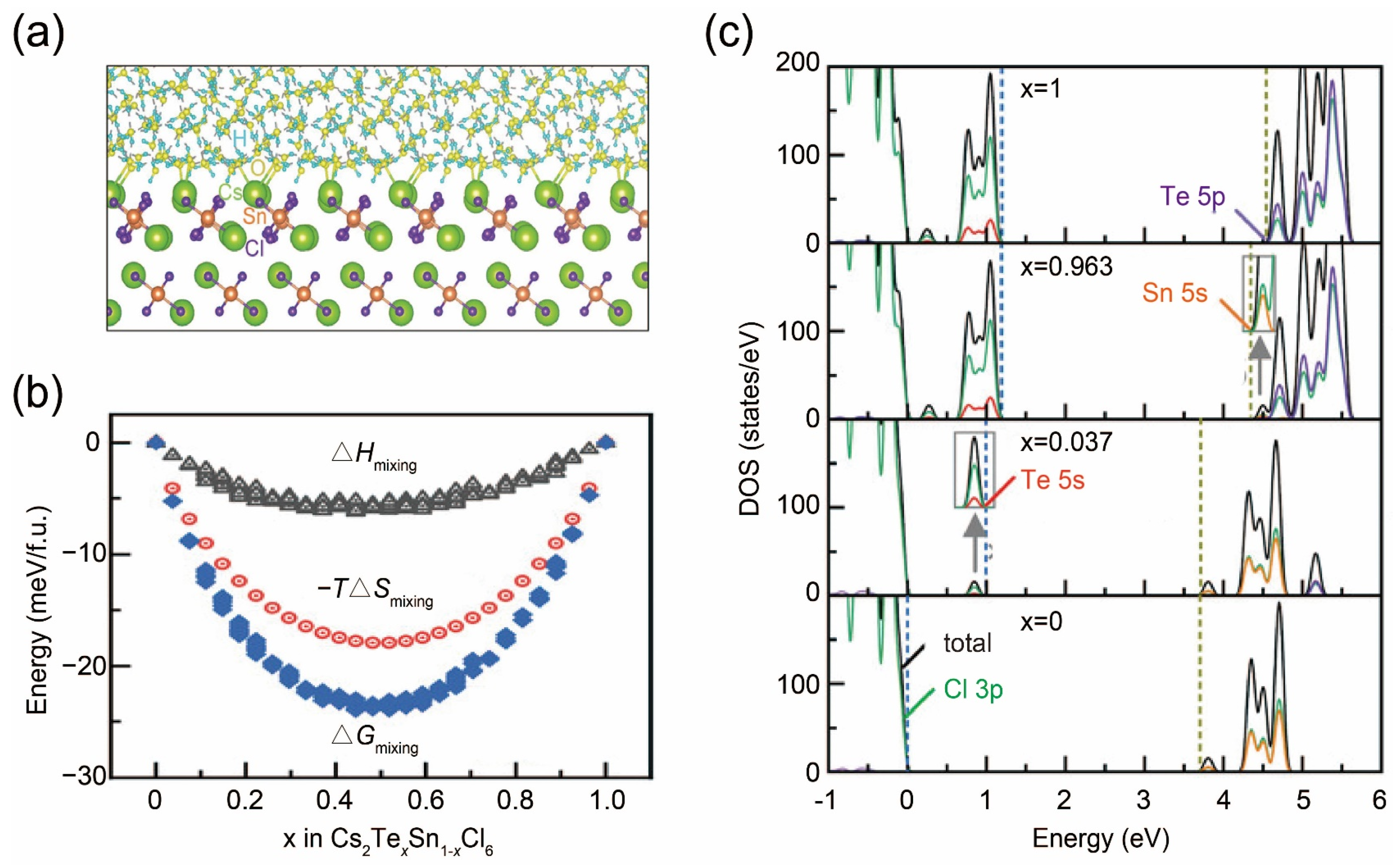
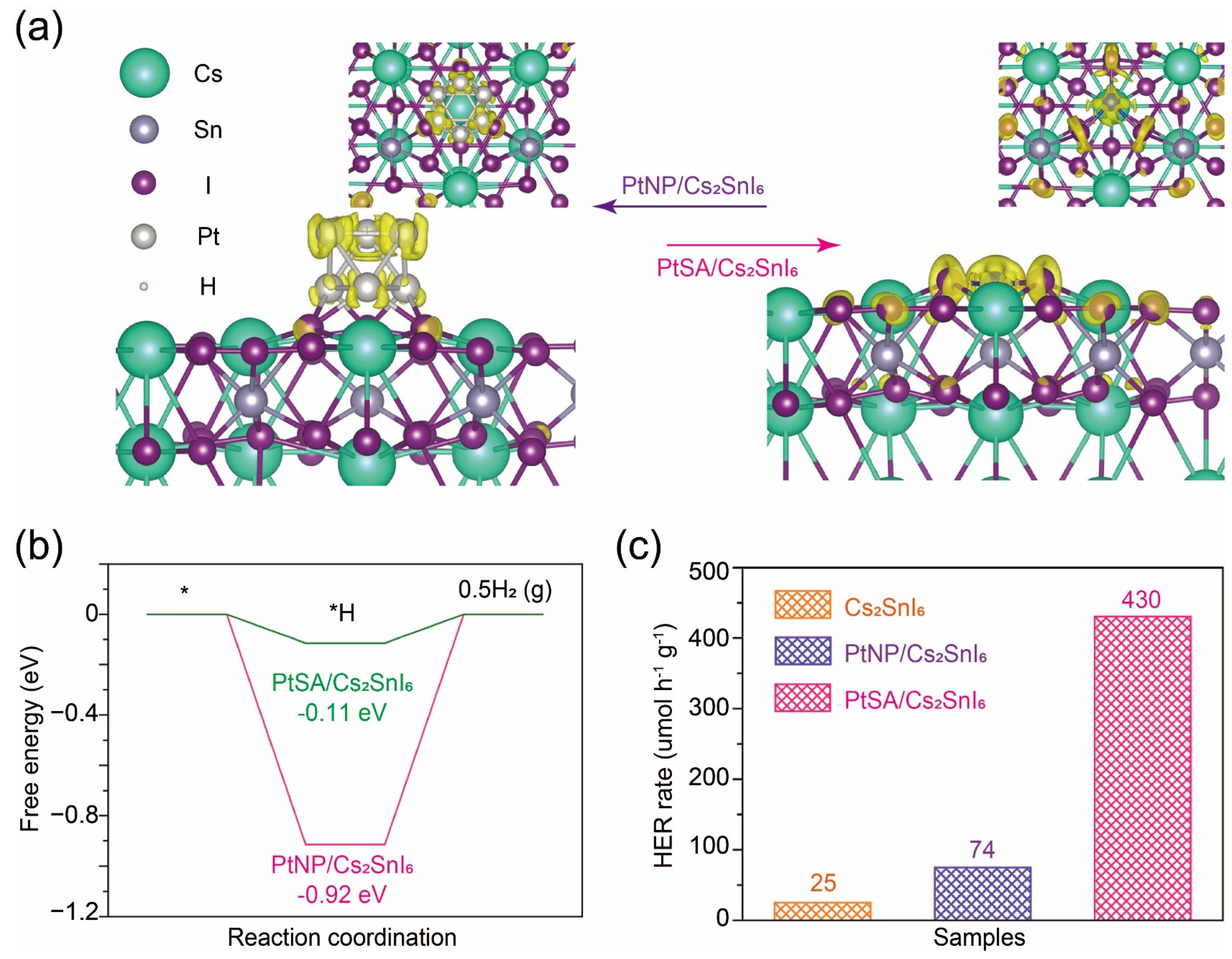
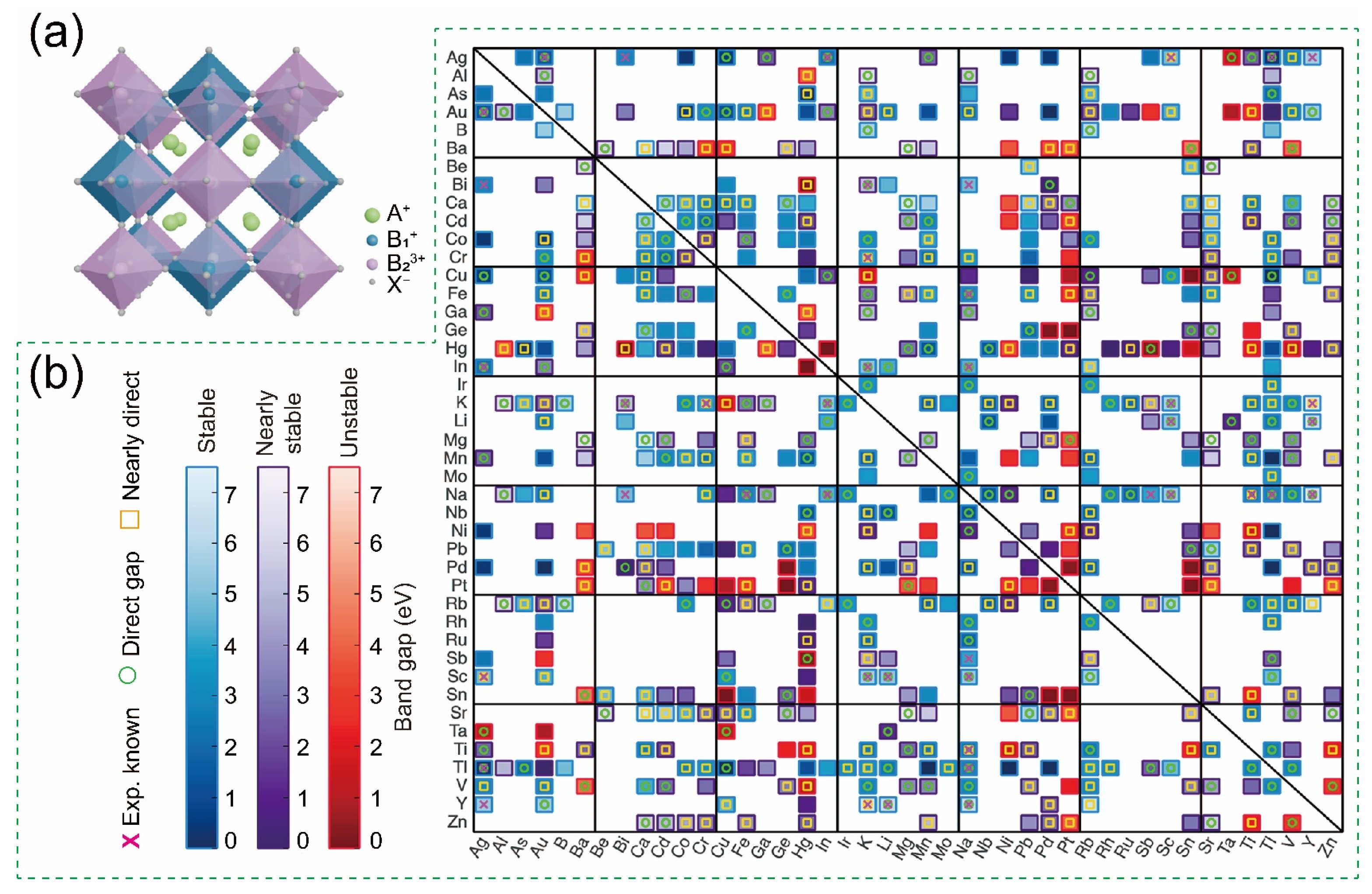
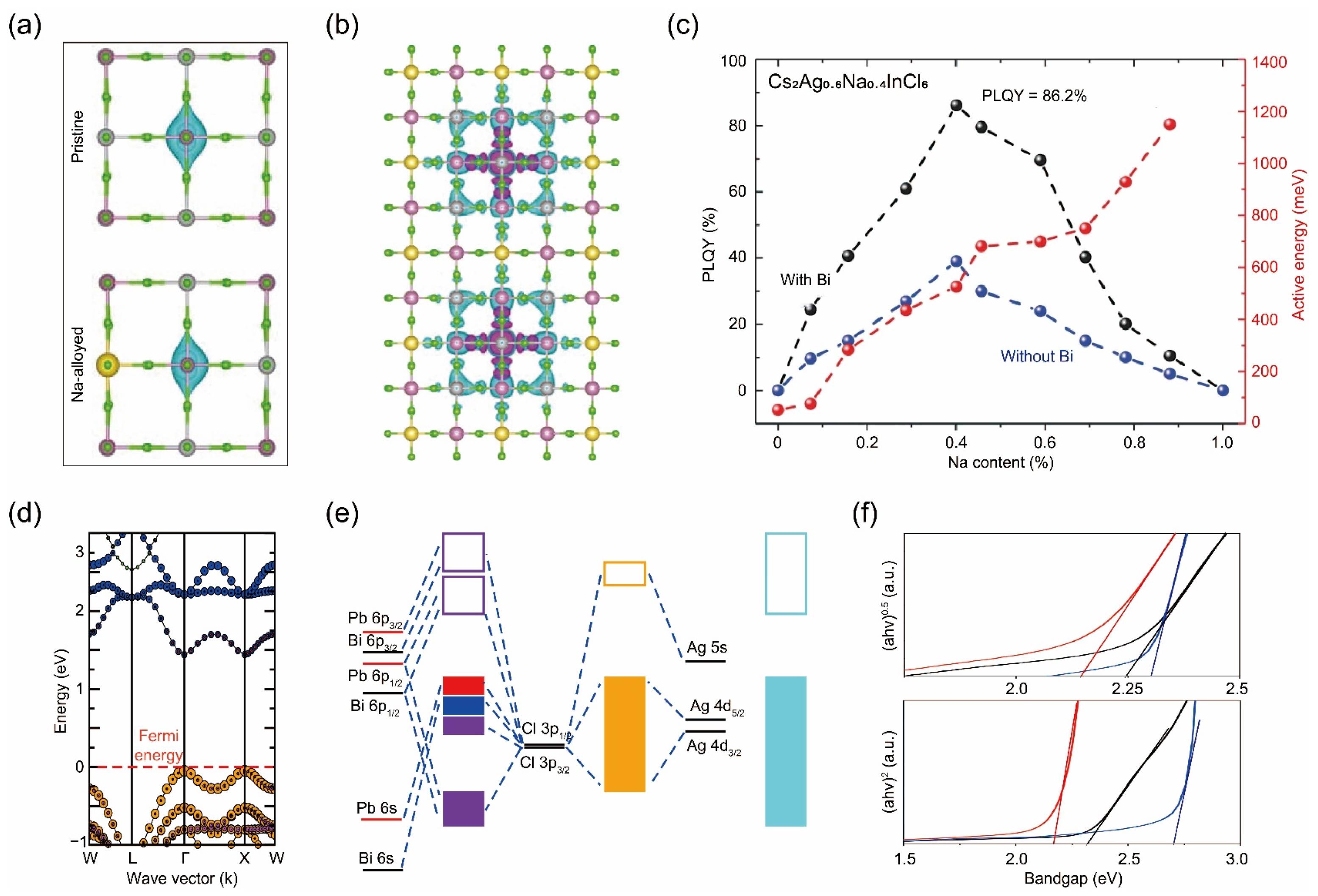
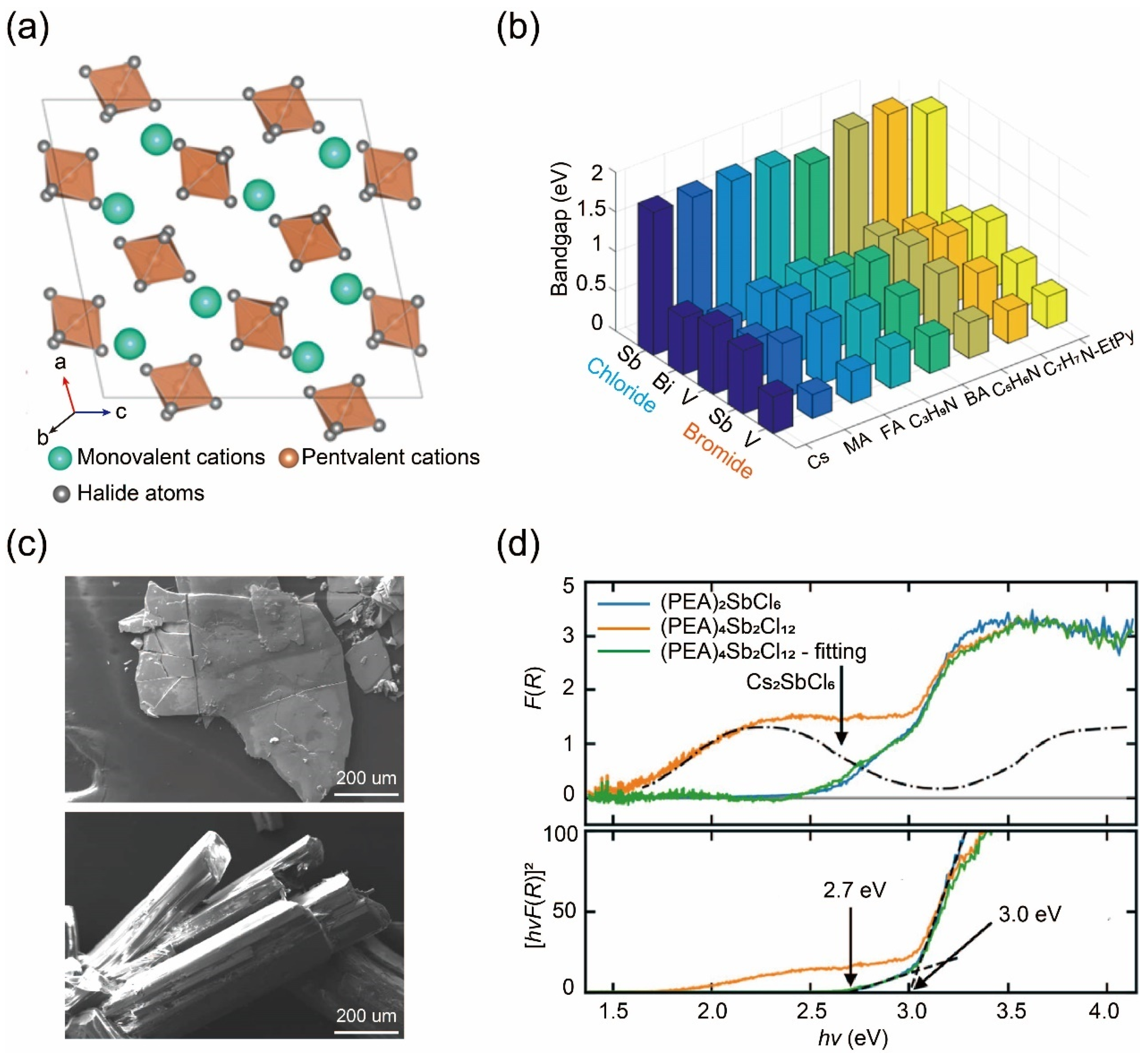
Disclaimer/Publisher’s Note: The statements, opinions and data contained in all publications are solely those of the individual author(s) and contributor(s) and not of MDPI and/or the editor(s). MDPI and/or the editor(s) disclaim responsibility for any injury to people or property resulting from any ideas, methods, instructions or products referred to in the content. |
© 2024 by the authors. Licensee MDPI, Basel, Switzerland. This article is an open access article distributed under the terms and conditions of the Creative Commons Attribution (CC BY) license (https://creativecommons.org/licenses/by/4.0/).
Share and Cite
Sheng, M.; Zhu, H.; Wang, S.; Liu, Z.; Zhou, G. Accelerated Discovery of Halide Perovskite Materials via Computational Methods: A Review. Nanomaterials 2024, 14, 1167. https://doi.org/10.3390/nano14131167
Sheng M, Zhu H, Wang S, Liu Z, Zhou G. Accelerated Discovery of Halide Perovskite Materials via Computational Methods: A Review. Nanomaterials. 2024; 14(13):1167. https://doi.org/10.3390/nano14131167
Chicago/Turabian StyleSheng, Ming, Hui Zhu, Suqin Wang, Zhuang Liu, and Guangtao Zhou. 2024. "Accelerated Discovery of Halide Perovskite Materials via Computational Methods: A Review" Nanomaterials 14, no. 13: 1167. https://doi.org/10.3390/nano14131167




